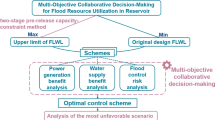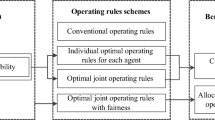Abstract
This paper presents an application of synergy methodology to a multiobjective operational control of reservoirs. This methodology enables a comprehensive consideration of multi-objectives which may be conflicting and non commensurate such as municipal and industrial water supply, flood protection, and hydroelectric power generation etc. On the basis of the synergy theory, a harmony degree model of subsystem was established to describe the coordination magnitude. Combined with information entropy, a harmony degree entropy was proposed to determine the water resources evolvement direction. While implementing the control, an initial scheme for reservoir operation was obtained from simulation first, then control was carried out according to the harmony degree and harmony degree entropy by applying synergy theory. The application of the methodology to reservoir system in the Yellow River was reported in this paper through a case study.
Similar content being viewed by others
References
Simonovic, S. P., Reservoir systems analysis: Closing gap between theory and practice, Journal of Water Resources Planning and Management, 1992, 118(3): 262–280.
Sharad, K. J., Marunohan, K. G., Puslipendra, K. A., Reservoir operation studies of sabarmati system, India Journal of Water Resources Planning and Management, 1998, 124(1): 31–37.
Kucaera, G., Diment, G., General water supply system simulation model, Journal of Water Resources Planning and Management, 1988, 114(4): 365–382.
Sigvaldason, O. T., A simulation model for operating a multipurpose multireservoir system, Water Resources Research, 12(2): 263–278.
Yeh, W. W.-G., Reservoir management and operations models: A state-of-the-art review, Water Resources Research, 1985, 21(12): 1797–1818.
Wurbs, R. A., Reservoir-system simulation and optimization models, Journal of Water Resources Planning and Management, 1993, 119(4): 455–472.
Andreu, J., Capilla, J., Sanchis, E., Aquatool, a generalized decision-support system for water-resources planning and operational management, Journal of Hydrology, 1996, 177(3): 269–291.
Elizabeth, A. E., Timothy, M., Edith, Z. et al., Goal programming decision support system for multiobjective operation of reservoir systems, Journal of Water Resources Planning and Management, 2001, 127(2): 108–120.
Florian, T. B., Diagan, A. S., Godfrey, A. W., Water reservoir control with data mining, Journal of Water Resources Planning and Management, 2003, 129(1): 26–34.
Makinde-Odusola, B. A., Marino, M. A., Optimal control of ground water by the feedback method of control, Water Resources Research, 1989, 25(5): 1341–1352.
McLaughlin, D., Velasco, H. L., Real-time control of a system of large hydropower reservoirs, Water Resources Research, 1990, 26(4): 623–635.
Oliveira, R., Loucks, D. P., Operating rules for multireservoir systems, Water Resources Research, 1997, 33(4): 839–852.
Author information
Authors and Affiliations
Corresponding author
Rights and permissions
About this article
Cite this article
Huang, Q., Chang, J., Wang, Y. et al. Synergy methodology for multi-objective operational control of reservoirs in Yellow River basin. Sci. China Ser. E-Technol. Sci. 47 (Suppl 1), 212–223 (2004). https://doi.org/10.1360/04ez0018
Received:
Issue Date:
DOI: https://doi.org/10.1360/04ez0018




